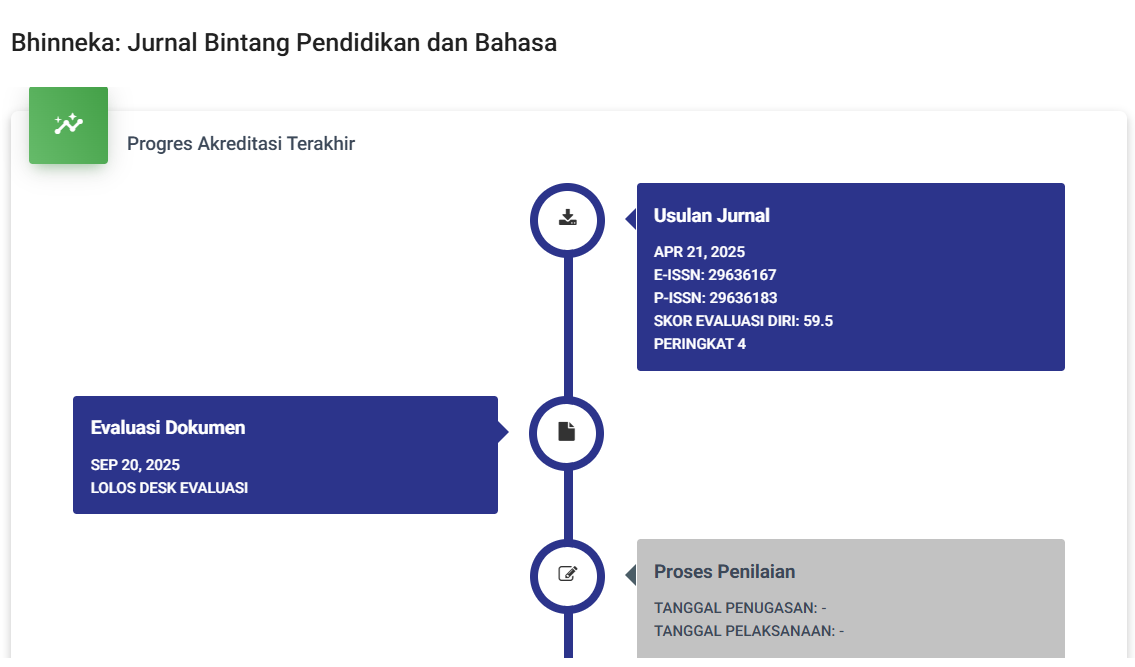Penerapan Media Postcard untuk Meningkatkan Keaktifan Siswa SMK Ma’arif NU Kajen Tahun 2021/2022
DOI:
https://doi.org/10.59024/bhinneka.v2i4.1058Keywords:
Learning Media, Postcards, Student ActivityAbstract
The learning model applied during the COVID-19 pandemic has changed the way students learn, so that student activity in the learning process in class is still low and there are many student absences after the pandemic. Almost 2 years of the pandemic have required students to study from their respective homes so that students are increasingly lazy or less active in learning. This is the basis for the idea of how to make them more effective in learning by using postcard media. Postcard media is a media containing questions related to learning that must be answered by students by taking lucky coupons. The purpose of this study is 1) To describe the teacher's process in implementing postcard media in building student activity in learning in class XI of SMK Ma'arif NU Kajen. 2) To analyze the level of student activity of class XI of SMK Ma'arif NU Kajen through the application of postcard media in learning. This classroom action research was conducted at SMK Ma'arif NU Kajen with the research subjects of class XI students totaling 72 students with almost the same academic abilities, able to understand simple materials, but the level of student activity is low, the majority are less brave in expressing ideas, ideas and opinions. Data collection techniques include questionnaire sheets and documentation. Data analysis used is qualitative and quantitative data analysis. The results of the study showed that the process of implementing postcard media which was carried out through three stages, namely the process of designing a learning plan, the process of implementing learning, and the process of evaluating the use of learning media has been implemented well by teachers. In cycle I, the results of the questionnaire showed that the application of postcard media to increase student activity was successful with an average score reaching 86%. In cycle II, the application of postcard media to increase student activity was successful with an average questionnaire score reaching 88%. Postcard media has proven to be effective in increasing student activity in learning. For teachers, it is expected to be able to improve learning media so that students can be encouraged to be active in class. For schools, it is expected to be able to provide adequate facilities, especially the provision of teaching aids so that teachers can be more free in creating a creative learning process.
References
Adittia, A. (2017). Penggunaan Media Pembelajaran Audio Visual untuk Meningkatkan Hasil Belajar IPS Pada Siswa Kelas IV SD. Jurnal Mimbar Sekolah Dasar. 4 (1), 9-20
Arikunto, Suharsimi. (1998). Prosuder Penelitian Suatu Pendekatan Praktek. Jakarta: PT. Rineka Cipta.
Asra dan sumiati. (2007). Metode Pembelajaran Pendekatan Individual. Bandung: Rancaekek Kencana
Asyhar, Rayandra. (2012). Kreatif Mengembangan Media Pembelajaran. Jakarta: Referensi.
Bloom, Benjamin S. dkk. (1956). Taxonomy of Educational Objectives : The Classification of Educational Goals, Handbook I Cognitive Domain. New York : Longmans, Green and Co.
Gerlach, Vernon S., and Ely. (1971). Teaching and Media : A Systematic Approach. Prentice-Hall: Englewood Cliffs, N.J
Karo-Karo, I. R., & Rohani. (2018). Manfaat Media dalam Pembelajaran. 1, 6–8. https://doi.org/10.16309/j.cnki.issn.1007-1776.2003.03.004
Kemmis, S. & Mc. Taggart, R. (1988). The Action Research Planner. Victoria: Deakin University Press.
Khairunnisah. (2018). Peningkatan Kemampuan Siswa dalam Membaca Teks Bahasa Inggris Melalui Permainan Postcard From Jhon di Kelas VII MTs Muhammadiyah 22 Padangsidimpuan. Linguistik: Jurnal Bahasa dan Sastra, 3(1), 54-61.
Kristiningtyas, W. (2017). Peningkatan Hasil Belajar Siswa Aspek Kognitif dan Psikomotorik dalam Membuat Sketsa dan Peta Wilayah yang Menggambarkan Objek Geografi Melalui Metode Survei Lapangan. Refleksi Edukatika: Jurnal Ilmiah Kependidikan, 8(1), 28-34. Retrieved from https://jurnal.umk.ac.id/index.php/RE/articl e/view/1782.
Kunandar. (2016). Langkah Mudah Penelitian Tindakan Kelas. Jakarta: PT.Raja Grafindo Persada
Kuncahyono, K. (2018). Pengembangan E-Modul (Modul Digital) dalam Pembelajaran Tematik Di Sekolah Dasar. JMIE (Journal of Madrasah Ibtidaiyah Education), 2(2), 219–231.
Martin, W., Silander, M., & Rutter, S. (2019). Digital Games as Sources For Science Analogies: Learning About Energy Through Play. Computers and Education. https://doi.org/10.1016/j.compedu.2018.11.002.
Ningsih, A. (2018). Pengaruh Keaktifan Siswa Terhadap Hasil Belajar Ekonomi Kelas X di SMAN 2 Gunung Sahilan. Jurnal Pendidikan Ekonomi Akuntansi FKIP UIR, 6(2), 157–163.
Purwanto. (2009). Evaluasi Hasil Belajar. Yogyakarta: Pustaka Pelajar.
Sanjaya. (2008). Perencanaan dan Desain Sistem Pembelajaran. Jakarta: Kencana
Sardiman. (2001). Interaksi Dan Motivasi Belajar Mengajar. Jakarta: Raja Grafindo Persada
Siregar, R. D. Y. & Rahayu, T. (2021). Penerapan Model Pembelajaran Course Review Horay Tari No Tatema Mbola melalui Media Kartu Pos untuk Meningkatkan Efektivitas Pembelajaran di SMP Darussalam Medan. Gesture: Jurnal Seni Tari, 10(1), 17-26.
Suardani, N. M. (2021). Peningkatan Kemampuan Menulis Puisi dengan Menggunakan Media Postcard. Jurnal Ilmiah Sarasvati, 3(1), 1-17.
Sudjana, Nana. (2010). Penilaian Hasil Proses Belajar Mengajar. Bandung: PT Ringka Cipta.
Suparlan. (2006). Guru Sebagai Profesi. Yogyakarta: Hikayat Publishing, 2006.
Undang-Undang Republik Indonesia No. 20 tahun 2003 Tentang Sistem Pendidikan Nasional.
Usman, Moh Uzer. (2002). Menjadi Guru Profesional. Bandung: PT Remaja Rosdakarya
Downloads
Published
How to Cite
Issue
Section
License
Copyright (c) 2024 Bhinneka: Jurnal Bintang Pendidikan dan Bahasa

This work is licensed under a Creative Commons Attribution-ShareAlike 4.0 International License.








